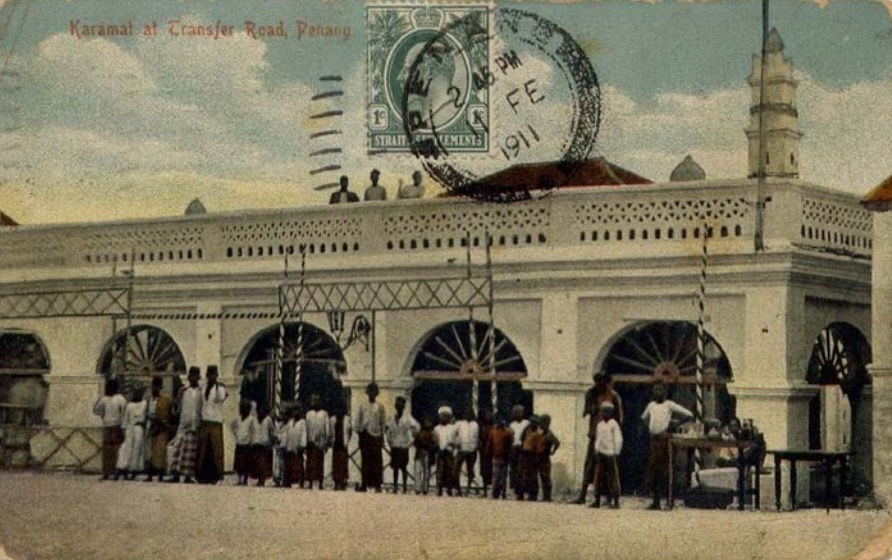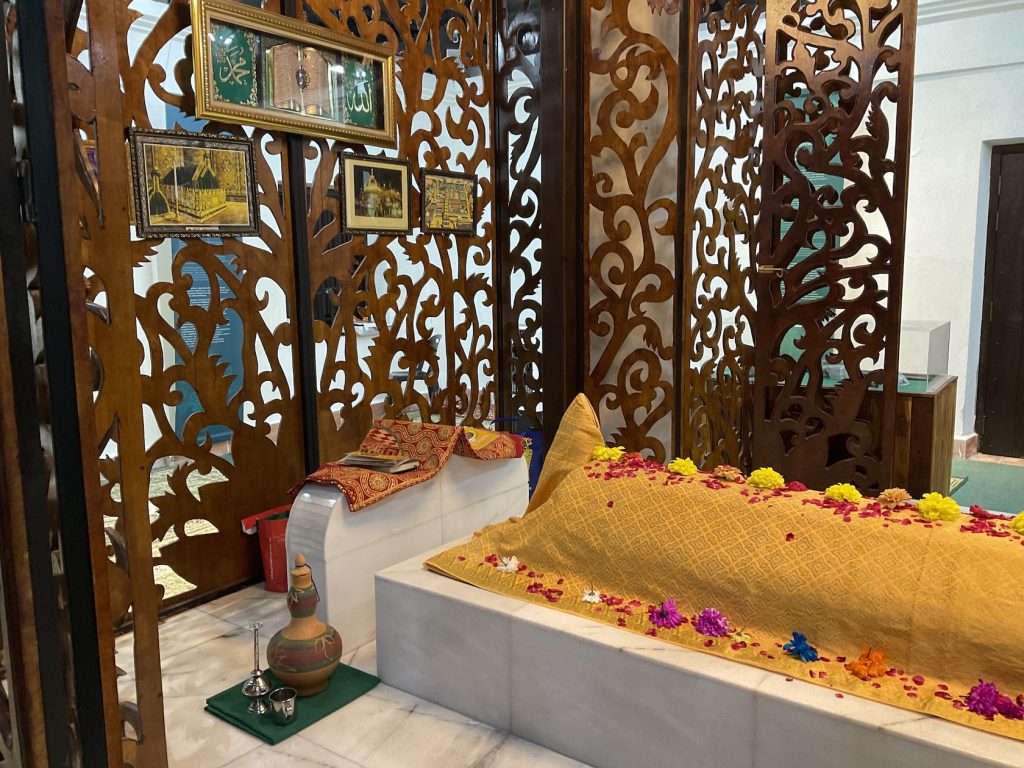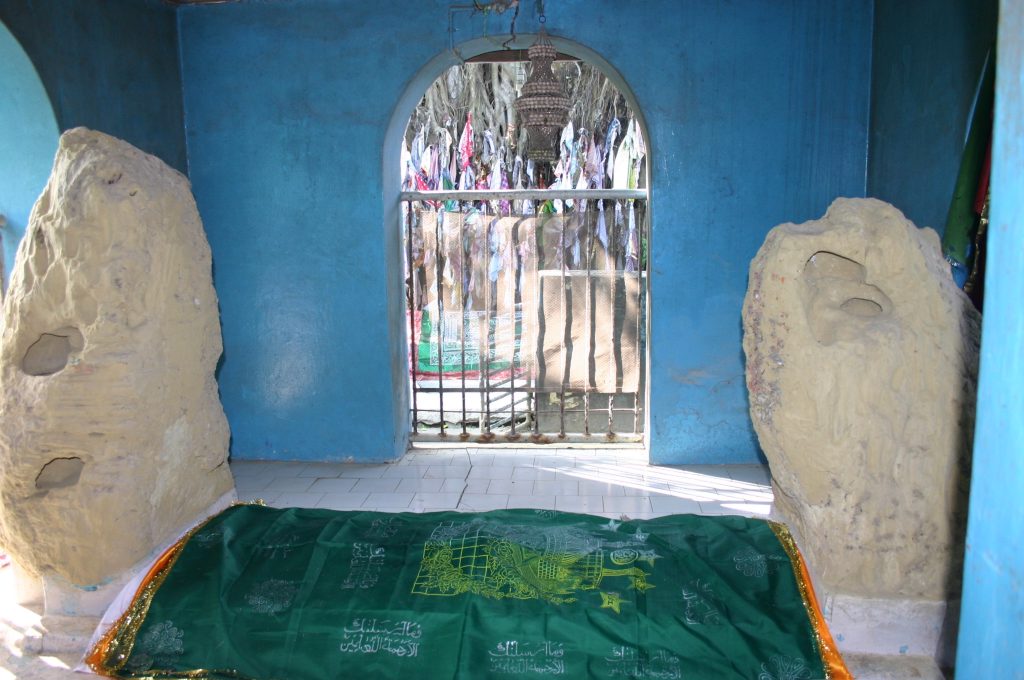On Transfer Road, in the UNESCO world heritage site of George Town Penang, there is a fascinating place called the Makam Dato Koyah. There lies buried a man who in his lifetime was known as Syed Mustapha Idris. A shrine (keramat) grew up around him after miraculous happenings followed his death in the middle of the 19th century (Figures 1 & 2).
Figure 1: Kramat at Transfer Road, postcard dated 1911

I first read about the keramat many years ago and was thrilled to have the chance to visit it in December 2022. At that time, my colleague Lorraine Paterson and I were warmly welcomed by members of the community who look after the shrine. They had overseen a large-scale conservation project, in collaboration with architects and builders, which began in 2015 and is still ongoing. Readers who are interested in this kind of heritage work can read details of it here, and I had the good fortune to meet one of the leads at the start of the conservation project, Gwynn Jenkins, early in 2023.
Last year, the community told us about the many oral histories that are associated with the keramat, and historians like Khoo Salma Nasution have written about these. Passed down from generation to generation, particularly by women, Syed Mustapha is said to have been wrongfully convicted of murder somewhere along the Malabar coast, and sent to Penang as a convict, where he served seven years and was then released. (Penang was a penal settlement for Indian convicts from 1789 to 1873). They do not know exactly when he died (though a caretaker told researchers in 1974 that this was 1840), but the shrine grew up after local people heard chanting coming from his grave, which appeared to grow in length. By now known as the Dato Koyah (an honorific title), during his lifetime the Makam was said to have been able to complete the arduous road building works that engaged the convicts in the penal settlement overnight, to heal the sick, and to cook pots of porridge so plentiful that the food never ran out. Historically, local people of all faiths visited the site to pray for good fortune including in matters relating to marriage and fertility.
Figure 2: Interior of the Makam Dato Koyah

Photograph: Clare Anderson (2023)
In a previous blog, I wrote about a famous Singapore gurdwara, where the Sikh “saint soldier” convict Bhai Maharaj Singh is buried. It is interesting to think about the Makam Dato Koyah as another cultural and religious site that grew up during the convict era in the Straits Settlements and so is associated with the history of convict transportation in Southeast Asia during the same period. It is not known whether any keramats exist in the third place in the Straits associated with convicts, Malacca. However, there is a similar complex in the neighbouring Andaman Islands (now a Union Territory of the Republic of India), known as a mazar. This contains the graves of two convicts transported to the Andamans after the 1857 revolt (called the First War of Independence in India): Liaquat Ali and Fazl-i Haq Khairabadi (Figure 3). The latter wrote the only known 19th-century convict account of transportation to the Andaman Islands (there are few dating from the nationalist period in the 20th century).
Figure 3: Liaquat Ali’s Mazar, South Point, Andaman Islands

Photograph: Clare Anderson (2012)
As is well known, the Japanese occupied the Straits Settlements (by then also incorporating Labuan [1907] alongside Singapore, Penang, and Malacca) during World War II. This resulted in the destruction of the historical archives of the four colonies, copies of which are now held in the India Office Records of the British Library and (after the Straits were transferred from the India Office to the Colonial Office in 1867) The National Archives, in Kew. This creates a clear barrier to access for Malaysians – and shows the depth of the bureaucratic block that works against the decolonization of history.
Against this background, the University of Leicester allocated resources from its Knowledge Exchange, Impact, and Proof of Concept (KEIPOC) fund for me and Lorraine Paterson to travel back to Penang to share some of the historical documents on Penang that I have collected over the years with the community at the Makam Dato Koyah.
During a well-attended event that took place on 2 July 2023, we were able to show the community copies of archival material that contextualise the history of the Dato and the site in Penang, including paintings of convict ships, records of convict shipments, and details of the organisation of the penal settlement, and convict experiences of it, during the period in question.
We learned a great deal from the community, and as we discussed the materials together we thought about how we might move forward with creating an historical resource that will be of value to them. Together, we are now engaged in co-creating this, and the community has told us that it will make a difference to its knowledge of its history, and greatly assist those active members who routinely give tours to visitors from all over the world.
Clare Anderson
We would like to thank Adam Malik (Heritage Committee of Dato Koyah) and Zainal Alam (Central Muslim Society) for facilitating this collaboration, and Dr Rashid (Heritage Committee of Dato Koyah) for his kind assistance during our work together.